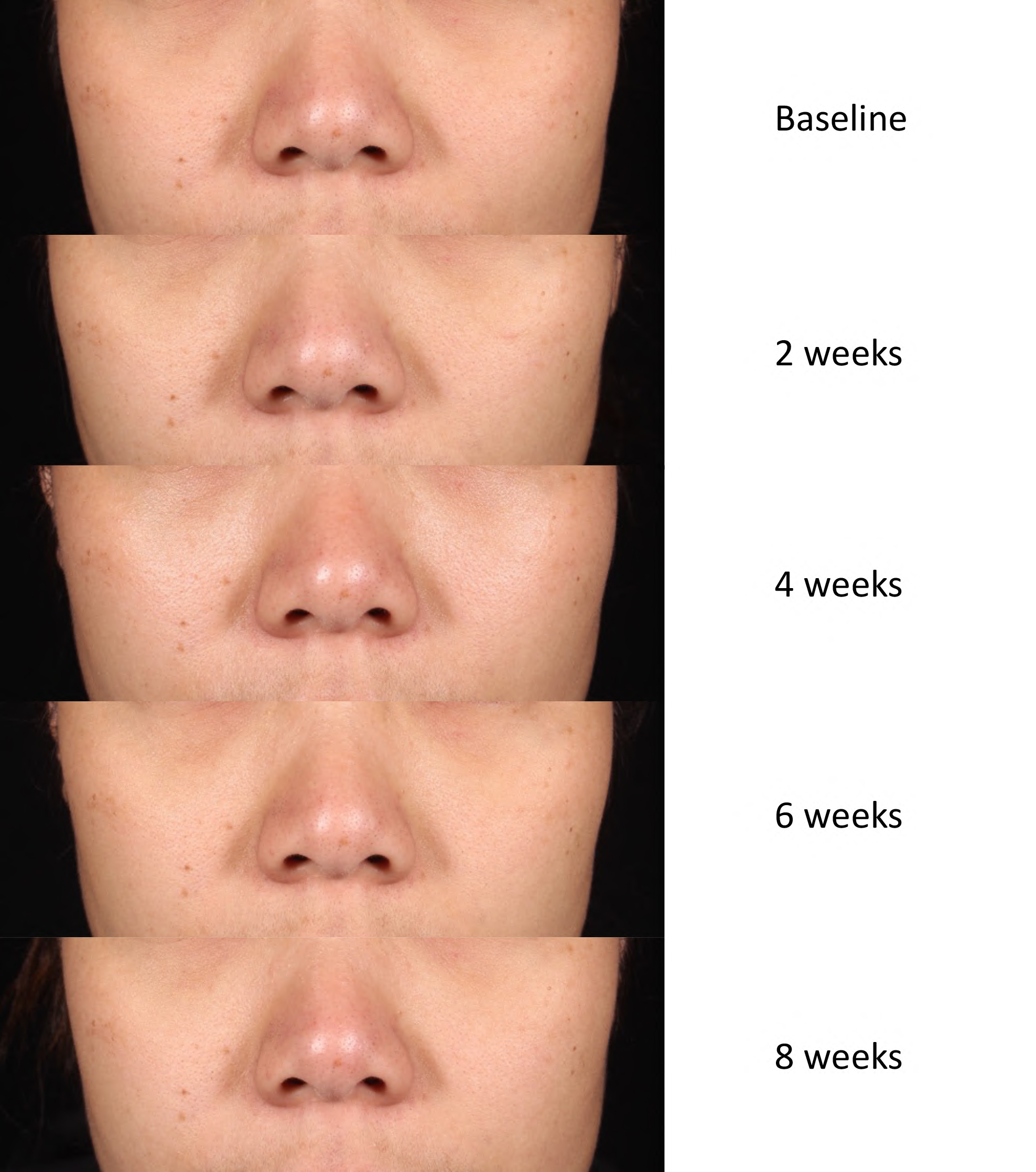Efficacy and Safety of a Home-Use Combination of Radiofrequency, Light-Emitting Diode, and Microcurrent Device for Skin Rejuvenation: A Split-Face Study
Keywords:
Radiofrequency, Light-emitting Diode, Microcurrent DeviceAbstract
Background: The use of radiofrequency (RF), light-emitting diodes (LED), and microcurrent have been reported previously for skin rejuvenation. The constant demand for ameliorating the skin signs of aging have been met by more and more home-use devices being available to the public.
Objective: To evaluate the efficacy and safety of a home-use device utilizing RF, red LED, and microcurrent.
Materials and Methods: This was a prospective split-face study with a total of 24 subjects who presented with signs of skin aging. All participants received treatment with the home-use device to their designated hemi-faces for 18 minutes per session, twice a week for 8 weeks. Primary outcomes were improvement in wrinkle size and depth by the Antera 3D® and volume difference in the mid- and lower face by Vectra-3D®. Secondary outcomes were changes in skin texture, elasticity, and skin hydration. Evaluations were done at baseline, and at 2-,4-,6-, and 8-week follow up. Participant’s self-improvement scores and adverse effects were also recorded.
Results: Twenty-two (92%) participants completed the study and follow-up assessment. There was no statistically significant improvement in wrinkle size and depth, as well as volume difference in the mid- and lower face. Skin texture was statistically significant improved at all assessment points, whereas both skin elasticity and hydration did not have significant changes. There were no treatment associated adverse effects and all participants tolerated the treatment well.
Conclusion: The home-use device utilizing RF, red LED, and microcurrent is safe and can be used as a self-administered adjunctive treatment for skin texture improvement.
References
Lipozenčić J, Bukvić Mokos Z. Dermatologic lasers in the treatment of aging skin. Acta Dermatovenerol Croat 2010;18:176-80.
Atiyeh BS, Dibo SA. Nonsurgical nonablative treatment of aging skin: radiofrequency technologies between aggressive marketing and evidence-based efficacy. Aesthetic Plast Surg 2009;33:283-94.
Elsaie ML, Choudhary S, Leiva A, Nouri K. Nonablative radiofrequency for skin rejuvenation. Dermatol Surg 2010;36:577-89.
Ablon G. Phototherapy with light emitting diodes: treating a broad range of medical and aesthetic conditions in dermatology. J Clin Aesthet Dermatol 2018;11:21-7.
Opel DR, Hagstrom E, Pace AK, et al. Light-emitting diodes: a brief review and clinical experience. J Clin Aesthet Dermatol 2015;8:36-44.
Mercola J, Kirsch D. The basis for micro current electrical therapy in conventional medical. J Adv Med 1995;8.
Poltawski L, Watson T. Bioelectricity and microcurrent therapy for tissue healing-a narrative review. Phys Ther Rev 2009;14:104-14.
Kwon T-R, Moon DW, Kim J, et al. Application of 630-nm and 850-nm light-emitting diodes and microcurrent to accelerate collagen and elastin deposition in porcine skin. Medical Lasers 2021;10:96-105.
Gold MH, Biron J, Levi L, Sensing W. Safety, efficacy, and usage compliance of home-use device utilizing RF and light energies for treating periorbital wrinkles. J Cosmet Dermatol 2017;16:95-102.
Juhász ML, Levin MK, Marmur ES. A review of available laser and intense light source home devices: a dermatologist's perspective. J Cosmet Dermatol 2017;16:438-43.
Fitzpatrick RE, Goldman MP, Satur NM, Tope WD. Pulsed carbon dioxide laser resurfacing of photo-aged facial skin. Arch Dermatol 1996;132:395-402.
Beilin G. Home-use TriPollar RF device for facial skin tightening: Clinical study results. J Cosmet Laser Ther 2011;13:69-76.
Shemer A, Levy H, Sadick NS, Harth Y, Dorizas A. Home-based wrinkle reduction using a novel handheld multisource phase-controlled radiofrequency device. J Drugs Dermatol 2014;13:1342-7.
Sadick NS, Harth Y. A 12-week clinical and instrumental study evaluating the efficacy of a multisource radiofrequency home-use device for wrinkle reduction and improvement in skin tone, skin elasticity, and dermal collagen content. J Cosmet Laser Ther 2016;18:422-7.
Omi T. Evaluation of the safety and efficacy of continuous use of a home-use high-frequency facial treatment appliance. J Cosmet Dermatol Sci Appl 2018;8:25-34.
Nobile V, Michelotti A, Cestone E. A home-based eyebrows lifting effect using a novel device that emits electrostatic pulses containing RF energy, resulting in high frequency, low level transdermal microcurrent pulsations: Double blind, randomized clinical study of efficacy and safety. J Cosmet Laser Ther 2016;18:234-8.
Mueller J, Kapeller B, Losert U, et al. Electrical microcurrent application modifies the inflammatory response in the failing myocardium. Clin Immunol 2006;119:S128.
Ng JNC, Wanitphakdeedecha R, Yan C. Efficacy of home-use light-emitting diode device at 637 and 854-nm for facial rejuvenation: A split-face pilot study. J Cosmet Dermatol 2020;19:2288-94.

Downloads
Published
How to Cite
Issue
Section
License
Copyright (c) 2022 Thai Journal of Dermatology

This work is licensed under a Creative Commons Attribution-NonCommercial-NoDerivatives 4.0 International License.
เนื้อหาและข้อมูลในบทความที่ลงตีพิมพ์ในวารสารโรคผิวหนัง ถือเป็นข้อคิดเห็นและความรับผิดชอบของผู้เขียนบทความโดยตรงซึ่งกองบรรณาธิการวารสาร ไม่จำเป็นต้องเห็นด้วย หรือร่วมรับผิดชอบใดๆ
บทความ ข้อมูล เนื้อหา รูปภาพ ฯลฯ ที่ได้รับการตีพิมพ์ในวารสารโรคผิวหนัง ถือเป็นลิขสิทธิ์ของวารสารฯ หากบุคคลหรือหน่วยงานใดต้องการนำทั้งหมดหรือส่วนหนึ่งส่วนใดไปเผยแพร่ต่อหรือเพื่อกระทำการใดๆ จะต้องได้รับอนุญาตเป็นลายลักอักษรจากบรรณาธิการวารสารโรคผิวหนังก่อนเท่านั้น


